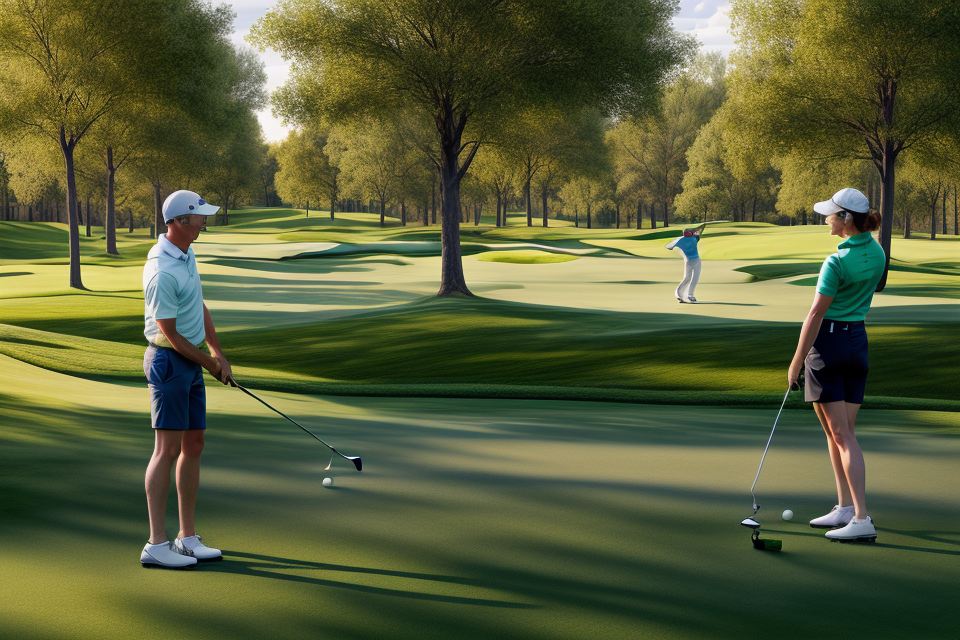
Are you tired of struggling to hit the ball further on the golf course? It’s time to put away those long swings and try something new. With these expert tips and techniques, you’ll learn how to hit a golf ball further with a shorter swing. You’ll discover the secrets to increasing your power and accuracy, without sacrificing your control. So whether you’re a beginner or a seasoned pro, get ready to take your game to the next level.
Understanding the Mechanics of a Short Swing
The Role of the Arms and Wrists
One of the key components of a shorter swing is the role of the arms and wrists. To maximize distance, it’s important to understand how these parts of the body should move during the swing.
Reducing the Swing for Longer Distance
Reducing the overall swing can be an effective way to increase distance. By taking a shorter swing, you’ll be able to generate more power and control, leading to straighter shots and greater distance. This can be achieved by making a smaller backswing and using a faster, more direct path to the ball on the downswing.
Keeping the Arms and Wrists Relaxed
During the swing, it’s important to keep the arms and wrists relaxed. Tension in these areas can lead to a loss of power and control, and can cause the ball to travel off-target. To keep the arms and wrists relaxed, focus on keeping them loose and flexible throughout the swing, and avoid tensing up or over-exerting yourself.
In addition to keeping the arms and wrists relaxed, it’s also important to maintain a smooth, rhythmic swing. This can be achieved by using a steady, controlled tempo, and by avoiding any jerky or erratic movements.
By focusing on reducing the swing and keeping the arms and wrists relaxed, you can maximize your distance and control on the golf course. With practice and patience, you’ll be able to develop a shorter, more effective swing that will help you hit the ball further and straighter.
The Importance of a Smooth Takeaway
The takeaway is the initial stage of the golf swing, where the golfer moves the club away from the ball. A smooth takeaway is crucial to setting up a proper swing and generating power. Here are some key points to keep in mind when working on a smooth takeaway:
- Start with the right grip: The grip is the foundation of the swing, so it’s essential to hold the club correctly. The right hand should be placed on the handle, with the fingers wrapping around it, and the thumb resting on top. The left hand should be placed on the grip, with the fingers wrapping around it, and the thumb resting on the bottom.
- Keep the hands and arms relaxed: Tension in the hands and arms can lead to a stiff and jerky takeaway, which can throw off the rest of the swing. Keep the hands and arms relaxed and allow them to move naturally with the body.
- Use the legs and core: The legs and core play a vital role in the takeaway, as they generate the power that propels the club forward. Engage the legs and core, and use them to initiate the swing.
- Avoid lifting the head: Lifting the head during the takeaway can lead to a jerky and unbalanced swing. Keep the head down and focused on the ball, and let the body move naturally.
- Use a full shoulder turn: A full shoulder turn is essential for a smooth takeaway and a powerful swing. Turn the shoulders away from the ball, and keep them relaxed and loose.
By focusing on these key points, golfers can develop a smooth takeaway that sets them up for a powerful and accurate swing.
Shortening Your Swing for Greater Distance
Focusing on a Shorter Backswing
One of the most effective ways to hit a golf ball further with a shorter swing is by focusing on a shorter backswing. A shorter backswing allows you to generate more speed and power at the point of impact, which can result in longer drives. Here are some tips on how to shorten your backswing:
How to Shorten Your Backswing
- Start with a narrow stance: A narrower stance will help you maintain balance and control throughout your swing, allowing you to keep your swing shorter.
- Keep your hands ahead of the ball: By keeping your hands ahead of the ball at the start of your swing, you’ll be able to hit up on the ball and generate more power.
- Use a shorter swing arc: Instead of trying to make a big, sweeping arc with your swing, focus on making a shorter, more controlled movement.
- Accelerate through impact: As you approach impact, focus on accelerating through the ball, which will help you generate more power and distance.
Benefits of a Shorter Backswing
- Increased power: By shortening your backswing, you’ll be able to generate more power and speed at the point of impact, resulting in longer drives.
- Improved accuracy: A shorter backswing can help you maintain better balance and control throughout your swing, which can lead to improved accuracy.
- Reduced risk of injury: A shorter swing is less likely to result in injury, as it places less stress on your body and reduces the risk of overexertion.
Overall, focusing on a shorter backswing is a great way to hit a golf ball further with a shorter swing. By following these tips and techniques, you can improve your power, accuracy, and reduce your risk of injury on the golf course.
Maintaining Acceleration Through Impact
The science of acceleration is based on the principles of physics, which dictate that an object in motion tends to stay in motion with the same speed and direction unless acted upon by an external force. In the context of golf, this means that the golf ball will continue to travel in the direction and at the speed it was hit, unless it is affected by factors such as wind or spin.
In order to maintain acceleration through impact, it is important to focus on the timing and sequence of your swing. This includes keeping your hands ahead of the clubhead during the backswing, and then turning your body and hips towards the target during the downswing. It is also important to maintain a consistent swing speed throughout the swing, and to avoid slowing down or rushing the swing at any point.
One way to maintain acceleration through impact is to use a “one-piece takeaway,” which involves keeping the clubhead and hands working together in a smooth, continuous motion during the backswing. This helps to maintain the speed and direction of the clubhead, and allows for a more powerful and accurate shot.
Another technique for maintaining acceleration through impact is to use a “power fade” or “draw” shot, which involves intentionally altering the spin or trajectory of the ball to achieve a desired result. By adjusting the loft of the clubface or the position of the ball in relation to your body, you can control the direction and distance of the shot, while still maintaining the speed and power of your swing.
Overall, maintaining acceleration through impact is crucial for hitting a golf ball further with a shorter swing. By focusing on the timing and sequence of your swing, using a one-piece takeaway, and adjusting your shot shape when necessary, you can achieve greater distance and accuracy on the golf course.
Tips for a Shorter, More Effective Swing
Proper Grip and Stance
Grip Tips for a Shorter Swing
- Place both hands on the grip, ensuring that the palms are facing towards the target.
- Position the hands slightly ahead of the ball, allowing for a more compact swing.
- Ensure that the right hand is dominant, with the right pinky resting on the shaft for added control.
- Keep the left hand firm, but not tight, to maintain control and prevent over-rotation.
Proper Stance for Maximum Distance
- Stand with your feet shoulder-width apart, ensuring a solid base for your swing.
- Position the balls of your feet on the ground, providing stability and control.
- Tilt your body forward slightly, allowing for a more compact swing and increased power.
- Bend your knees slightly, keeping your weight on your feet and allowing for fluid motion.
- Avoid locking your knees or hips, as this can restrict your swing and reduce power.
- Maintain a relaxed, upright posture, keeping your eyes on the ball and your weight balanced.
Powering Up Your Downswing
When it comes to hitting a golf ball further with a shorter swing, powering up your downswing is crucial. Here are some expert tips to help you achieve this:
Using Your Core for Power
One of the most effective ways to generate power in your swing is by using your core muscles. This includes your abdominals, lower back, and glutes. When you engage these muscles, you create a stable foundation for your swing, allowing you to transfer more power to the ball.
To use your core for power, start by setting up to the ball with your feet shoulder-width apart. From here, engage your abdominals by drawing your belly button towards your spine. You should feel a tightening sensation in your core muscles.
Next, take a slow and steady backswing, keeping your core muscles engaged throughout. As you approach impact, explosively rotate your hips and transfer your weight towards your front foot. This will help you create a powerful downward strike on the ball.
Proper Timing for a Shorter Swing
Proper timing is essential for a shorter swing, as it helps you make solid contact with the ball and maintain control over your shot. Here are some tips to help you achieve proper timing:
- Keep your hands ahead of the ball at address, which will help you maintain a good tempo throughout your swing.
- Take a slow and deliberate backswing, focusing on making a full shoulder turn.
- As you approach impact, let your arms naturally extend, which will help you make solid contact with the ball.
- Finish your swing with a firm follow-through, keeping your weight on your front foot.
By focusing on these tips, you can power up your downswing and hit the golf ball further with a shorter swing. Remember to practice these techniques on the driving range and incorporate them into your game for maximum results.
Post-Swing Analysis
- Reviewing Your Swing for Improvement
- Tips for Perfecting Your Shorter Swing
Post-swing analysis is a crucial step in improving your golf game. It involves taking a closer look at your swing after you’ve hit a shot, and identifying areas that need improvement. Here are some tips for conducting a post-swing analysis:
- Look for areas of inconsistency: Pay attention to areas where your swing varies from shot to shot. This could be your backswing, downswing, or follow-through. Identifying these inconsistencies can help you identify areas where you need to make adjustments.
- Use video analysis: A video of your swing can provide valuable insights into your technique. You can view your swing from multiple angles and see what you’re doing well and what needs improvement. Many golf courses and driving ranges offer video analysis services, or you can use a smartphone app to record your swing and analyze it later.
- Focus on the fundamentals: It’s important to remember that the basic principles of a good golf swing remain the same, regardless of the length of your swing. Make sure you’re focusing on the fundamentals, such as maintaining a smooth rhythm, keeping your head still, and making a full shoulder turn.
- Practice your post-swing routine: Your post-swing routine can have a big impact on your ability to learn from each shot. Make sure you’re taking the time to analyze your swing and make adjustments as needed. This might involve taking a few practice swings or hitting a few balls on the practice range.
- Don’t get discouraged: It’s natural to have some bad swings now and then. Don’t get discouraged if you hit a bad shot or make a mistake in your swing. Instead, use it as an opportunity to learn and improve. Take a deep breath, stay positive, and focus on making the next shot your best one.
FAQs
1. What is a shorter swing in golf?
A shorter swing in golf refers to a technique where the golfer reduces the length of their swing in order to generate more power and control. This is achieved by reducing the distance the club travels during the swing, while still maintaining a smooth and balanced motion.
2. Why should I use a shorter swing in golf?
Using a shorter swing in golf can help increase power and accuracy, particularly for those with slower swing speeds or limited flexibility. It can also help reduce the risk of injury and improve overall control over the golf ball.
3. How can I reduce the length of my golf swing?
To reduce the length of your golf swing, focus on making a smooth and balanced motion. Take shorter and more controlled practice swings, and aim to bring the club back to the ball at the top of your backswing. Avoid using a long and slow backswing, as this can lead to a loss of power and control.
4. How can I maintain power with a shorter swing?
To maintain power with a shorter swing, focus on using your core muscles and keeping your swing smooth and balanced. Use your legs and hips to generate power, rather than relying solely on your arms. Also, be sure to use a club that is appropriate for your height and swing speed, as using a club that is too long can make it difficult to maintain power.
5. How can I improve my accuracy with a shorter swing?
To improve your accuracy with a shorter swing, focus on making a smooth and balanced motion, with a short and controlled backswing. Avoid making any sudden movements or swinging too fast, as this can lead to loss of control and accuracy. Also, be sure to use a consistent grip and stance, and pay attention to your body position and alignment throughout the swing.


